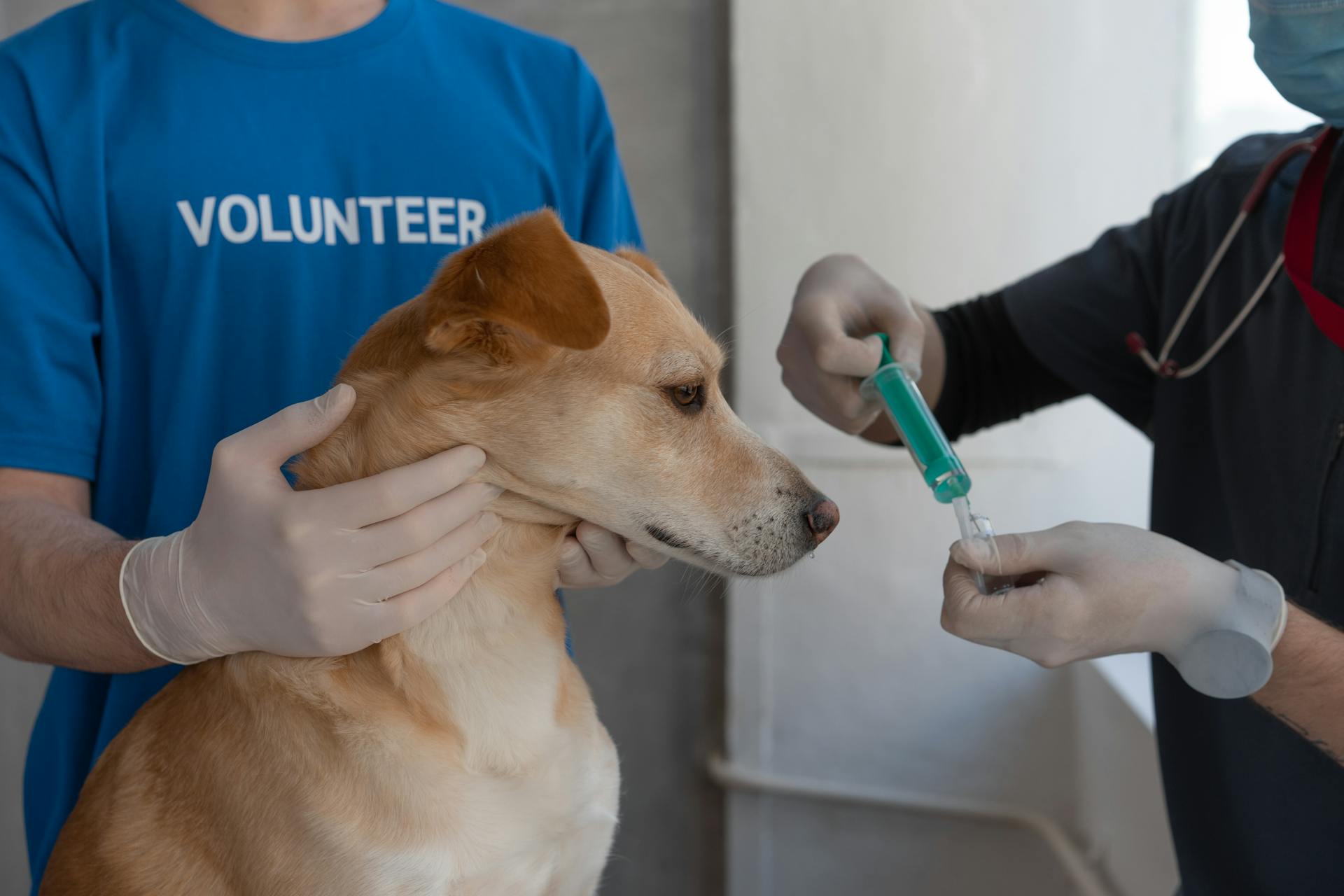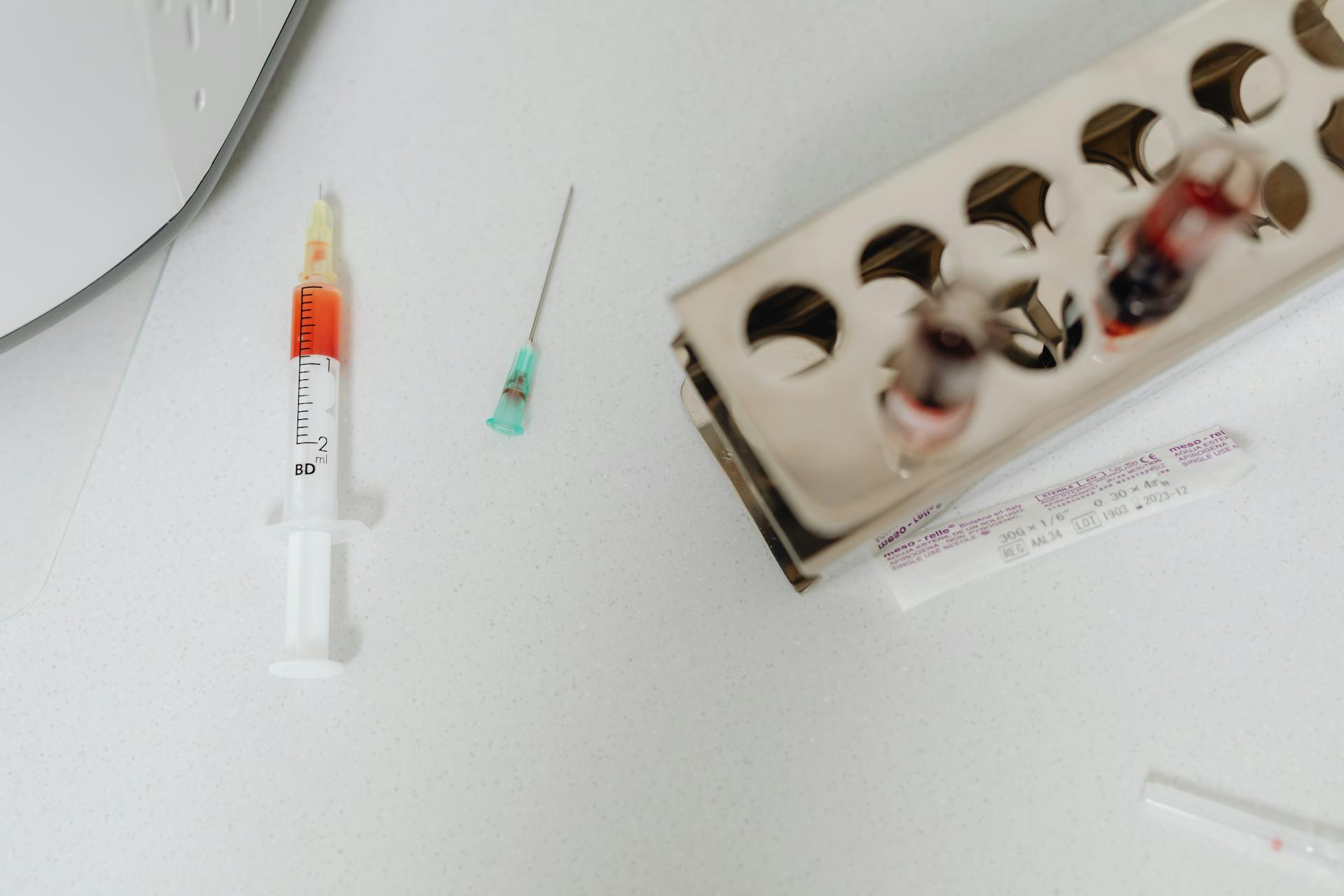
Canine parvovirus is a highly contagious and potentially life-threatening disease that affects dogs worldwide. It's a leading cause of death in puppies under six months old.
The virus is most commonly spread through contact with an infected dog's feces, which can contaminate food, water, and surfaces. This makes proper hygiene and vaccination crucial in preventing the spread of the disease.
Symptoms of parvovirus infection in dogs typically include vomiting, diarrhea, lethargy, and loss of appetite. These symptoms can progress rapidly, making prompt veterinary care essential.
In severe cases, parvovirus can cause dehydration, electrolyte imbalances, and even organ failure, which can be fatal if left untreated.
Explore further: Symptoms of Canine Lupus
Diagnosis Methods
A CPV diagnosis can be made through several methods, but the most common and convenient one is the fecal ELISA test, which can usually be completed by your veterinarian in less than 15 minutes.
The ELISA test is fairly accurate, but it can occasionally produce false positive or false negative results, so further testing may be necessary to confirm a diagnosis.
Veterinarians may also use a fecal PCR test to diagnose CPV from fecal samples, which is very accurate but requires sending the sample to a laboratory that specializes in PCR-based testing, taking more time than the ELISA test.
How Will My Vet Diagnose CPV?
Your vet will likely use a fecal ELISA test to diagnose CPV, which can be completed in under 15 minutes and is fairly accurate, but may occasionally produce false positive or false negative results.
The ELISA test works by detecting antibodies to parvovirus in a fecal sample, which changes color if parvoviruses are present.
Your vet may also use a PCR test, which detects small pieces of viral DNA specific to CPV in the stool, but this requires sending a fecal sample to a specialized laboratory and takes more time.
A low white blood cell count can also be a sign of CPV infection, as the parvovirus infects the bone marrow.
If your vet gets a positive ELISA reading and a low white blood cell count, they may be fairly confident in a CPV diagnosis.
Expand your knowledge: Dog Blood Work
Virus Isolation
Virus isolation is a crucial step in diagnosing viral infections, and it involves isolating the virus from a patient's sample. This is typically done by inoculating the sample onto a cell line, such as the Crandall Reese feline kidney (CRFK) cell line.
You might enjoy: How to Collect Urine from a Female Dog
To prepare the sample, it's first diluted to 10% in PBS, centrifuged to remove particulate material, and filtered through a 0.2-μm filter. This helps to remove bacteria and other contaminants.
The sample is then inoculated onto the CRFK cell line, and after 1 hour, minimum essential medium containing 5% fetal calf serum is added. The cells are observed daily for 6 days postinoculation for cytopathic effects, such as rounding and detachment.
The sample can also be extracted with an equal volume of chloroform and vortexed for 1 min before being centrifuged and filtered. This helps to release the virus from the sample.
Testing Types
ELISAs, IFA tests, and HI tests are used to determine antibody titers in canine parvovirus-2. The HI test is considered the gold standard.
In-clinic ELISAs are commercially available and one is reported to correlate well with current gold standard tests.
On a similar theme: Healthy Mind Canine - Separation Anxiety Training
Antibody Tests
Antibody tests are useful for monitoring immunity to Canine Parvovirus-2 (CPV-2). They can help determine if a dog has enough antibodies to fight off the virus.
Several types of antibody tests are available, including enzyme-linked immunosorbent assays (ELISAs), indirect immunofluorescence antibody (IFA) tests, and hemagglutination inhibition (HI) tests. The HI test is considered the gold standard.
Antibody tests can be performed on serum, and several in-clinic ELISAs are commercially available. At least one of these tests has been reported to correlate well with current gold standard tests.
Measuring antibody titers from the mother before whelping can determine Maternal Derived Antibody (MDA) levels. Similarly, puppies can have titers measured after whelping to determine their level of protection and potential for MDA-associated vaccine interference.
A positive titer should be present 2 weeks after the final vaccination. Puppies with an HI titer ≤1:80 are considered susceptible to infection.
If the antibody test is negative or the titer is ≤1:80, the dog should be revaccinated and the antibody test should be repeated 2 weeks later. If the dog remains negative, it may be a nonresponder, meaning it has adequate innate or cell-mediated immunity to provide some protection.
A fresh viewpoint: Canine Parvovirus 2 Life Cycle
Fig. 2

The slide agglutination test, or SAT, is a reliable method for detecting canine parvovirus.
A canine parvovirus-negative sample will not show any agglutination, or clumping, of porcine erythrocytes.
This lack of agglutination is a clear indication that the sample is negative for the virus.
In the case of FIG. 2, the sample showed no clumping of porcine erythrocytes, confirming that it is a canine parvovirus-negative sample.
Interference and Results
Maternally derived antibodies (MDA) can neutralize vaccines, preventing the induction of durable immunity in puppies. This means that puppies with high concentrations of MDA may not respond well to the vaccine.
Puppies without MDA can develop immunity as soon as 3 days postvaccination with MLV vaccines. MLV vaccines are likely to provide more robust immunity than killed vaccines in puppies with MDA.
The duration of immunity following killed vaccine administration is at least 6 months.
Sources of Interference
Maternally derived antibodies (MDA) can neutralize vaccines, preventing the induction of durable immunity in puppies. This happens because MDA are absorbed in utero and concentrated in the mammary gland during the final stages of pregnancy.
Puppies with high concentrations of MDA generally exhibit a poor response to the vaccine, which is relative to the amount of MDA in circulation at the time of vaccination.
In puppies without MDA, MLV vaccines can induce immunity as soon as 3 days postvaccination.
Results

Results are clear when we understand the impact of interference on our lives.
In the context of electromagnetic waves, interference can cause signal loss or degradation, leading to poor communication reception.
The article highlights how radio-frequency interference (RFI) can disrupt wireless communication systems, affecting devices like Wi-Fi routers and cell phones.
Interference can also cause physical harm, such as overheating in electronic devices.
The study found that exposure to high levels of electromagnetic radiation can lead to increased body temperature, potentially causing health issues.
In many cases, simple measures like using shielding or changing the frequency of a device can minimize interference.
By understanding the causes and effects of interference, we can take steps to mitigate its impact and achieve better results.
Related reading: Can Wet Food Cause Diarrhea in Dogs
Figures
Figures are a crucial part of understanding canine parvovirus test results.
A negative result in the slide agglutination test (SAT) is indicated by the lack of agglutination of porcine erythrocytes.
Frequently Asked Questions
How much does it cost to test a dog for parvo?
The cost of a parvo test can range from $40 to $100, not including your vet's office visit fee. This cost may vary depending on the test and your location.
Sources
- https://www.vet.cornell.edu/departments-centers-and-institutes/baker-institute/research-baker-institute/canine-parvovirus
- https://todaysveterinarypractice.com/preventive-medicine/canine-parvovirus-vaccination/
- https://www.biogal.com/blog/in-clinic-diagnosis-of-acute-canine-parvovirus-infection/
- https://microchemlab.com/microorganisms/canine-parvovirus/
- https://www.ncbi.nlm.nih.gov/pmc/articles/PMC2620666/
Featured Images: pexels.com


